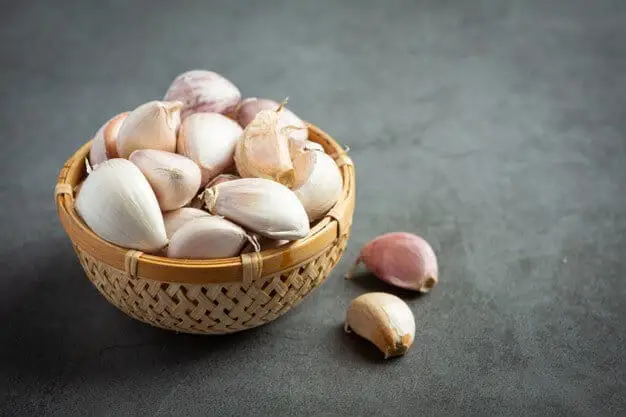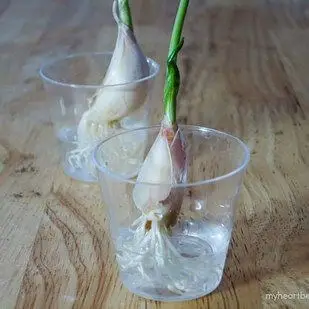Garlic is a highly sought-after plant that is used in various cuisines around the world. Its potent flavor and health benefits make it a necessary addition to your garden. However, there is one thing that most people do not know about garlic. In its culinary application, garlic is considered to be a great herb or spice. However, it is also classified as a vegetable by botanists. This is because a vegetable is any part of an herbaceous plant that can be eaten. Most people eat garlic bulbs but other parts of it such as its flowers and leaves are also consumed.
So if you’re considering planting garlic bulbs but do not have any planting space, I’ll recommend planting in water. In this article, I’ll be taking you through how you could plant garlic stems in water, the materials you’ll need, the conditions that you have to fulfill, and finally, the dos and don’ts of planting them.
Planting garlic in water is a little different from planting it in the soil. Unlike planting in soil, garlic planted in water leaves you unable to grow whole cloves. To grow garlic in water, you simply need to do the following:
Source for suitable cloves: By sourcing suitable cloves, I mean that you could check your pantry or local grocery store for cloves that are beginning to sprout leaves. These have a better chance of growing in comparison with cloves that haven’t begun sprouting. Although they might grow, their success rate is rather low.
However, if the only garlic cloves you have got haven’t begun to sprout, here’s a simple way to make them sprout. You’ll need just three ingredients, namely a clear cup (glass or plastic is suitable), fresh clean water, and the cloves. A clear cup is only advised to be used because you can easily tell when the fresh clean water gets dirty and you need to change it.
Pour some of the water into the clear cup that will be enough to cover only the base of the clove. This ensures that the garlic doesn’t get fully wet. Thus preventing it from rotting. Thereafter, place the garlic clove into the cup.
Place the cup somewhere in which the cloves will get adequate sunlight as garlic cloves grow under partial to full exposure to sunlight. Leave it for a couple of days and soon you’ll begin to see the green buds sprouting at the top of the cloves. This tells you that it’s ready to be grown.
A little tip to remember when sprouting your own garlic is to choose medium to large-sized cloves.
Plant sprouted cloves in water: This next step is similar to the method for initially sprouting cloves. Hence, if you chose to sprout your cloves keep changing the water when it gets dirty to grow your garlic. For those growing sprouted cloves, get a transparent bowl and some fresh clean water.
Pour some of the lukewarm clean water into the bowl. It should be enough to cover only the base of the garlic so that it doesn’t rot. Ensure that you use lukewarm water because hot water will most likely severely damage or eventually kill the cloves.
Place the cloves in the bowl of water with the end of the cloves facing upwards. Over time, the water will begin to get cloudy. Do change the water once you notice. Remember to remove the cloves first before changing the water to prevent them from fully getting wet.
Harvesting the sprouts: In a few weeks, the garlic sprouts will be ready for harvest. Some dishes such as salads and soups require the use of garlic sprouts because they have a milder garlic flavor. Here’s how to tell that they are ready for harvest. The shoots will have grown to a considerable height, perhaps 7 inches. Harvesting them before they fully mature will leave them bitter.
Next, using a pair of kitchen scissors, trim the top layers of the sprout as they’ll be less bitter. However, you should note that you might only be able to harvest the sprouts once.
Good to Read : The Easiest Tomatoes to Grow
The Best Garlic Varieties to Grow in Water

Now that you’ve learned how to grow your own garlic cloves in water, here’s some info about the best varieties to grow. They are:
Softneck varieties: Just as the name suggests, softneck varieties have soft stems that can be easily braided while it’s being dried. They are usually preferred for growing garlic leaves. The most common types you’ll find around include Korean red, Silverskin, Spanish ruga, Dujanski, and German red to name a few.
Hardneck varieties: Hardneck varieties are unlike their softneck counterparts. They are believed to be tough and have many layers of pods. They also have a rather unique ring of cloves. According to most, they have a rather traditional garlic taste that is more potent than that of the softneck varieties.
Elephant variety: The elephant garlic variety which is popularly called the bighorn garlic is not a favorite amongst many gardeners. However, its mild flavor makes it a favorite amongst many culinary experts.
The Dos and Don’ts of Growing Garlic in Water
In summary, here are the dos and don’ts of planting garlic in water.
- Do make use of a transparent container when growing garlic. Containers such as glass or clear plastic are see-through allowing you to tell if the water has become murky or dirty. Do change the water once it gets dirty.
- Don’t submerge the entire garlic in water. A third of its depth is enough else it’ll begin to rot.
- Do remove the garlic sprouts from the container before changing the murky water. This will prevent the entire bulb from getting soaked when the water is being changed. Once the water has been changed, you can then place the bulbs back into the water.
- Do place the garlic bulbs where they have full access to sunlight.
There you have it. A simple way to grow garlic in your home.
Want to know more about gardening ?
Fill in your email address in the form below and you'll receive all the latest updates directly in your in-box.
Thank you for subscribing.
Something went wrong.
